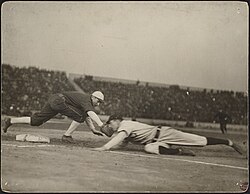
Back نهائيات كاس العالم 1906 ARZ World Series 1906 German Serie Mundial de 1906 Spanish World Series 1906 Italian 1906年のワールドシリーズ Japanese 1906年世界大賽 Chinese
| 1906 World Series | ||||||||||
|---|---|---|---|---|---|---|---|---|---|---|
 A program featuring league presidents Ban Johnson and Harry Pulliam, and National Baseball Commission President August Herrmann | ||||||||||
| ||||||||||
| Dates | October 9–14 | |||||||||
| Venue(s) | West Side Grounds (Chicago Cubs) South Side Park (Chicago White Sox) | |||||||||
| Umpires | Jim Johnstone (NL) Silk O'Loughlin (AL) | |||||||||
| Hall of Famers | White Sox: George Davis Ed Walsh Cubs: Mordecai Brown Frank Chance Johnny Evers Joe Tinker | |||||||||
| ||||||||||

The 1906 World Series was the championship series in Major League Baseball for the 1906 season. The third edition of the World Series, it featured a crosstown matchup between the American League champion Chicago White Sox and the National League champion Chicago Cubs. The Cubs had posted the highest regular-season win total (116) and winning percentage (.763) in the major leagues since the advent of the 154-game season. The White Sox, known as the "Hitless Wonders" after finishing with the worst team batting average (.230) in the American League, beat the Cubs in six games for one of the greatest upsets in Series history as the Sox out-pitched the Cubs in their first two wins and out-hit them in their last two. The home teams alternated, starting with the National League Cubs being home in Game 1.
The teams split the first four games; then the Hitless Wonders (a name coined by sportswriter Charles Dryden) exploded for 26 hits in the last two games. True to their nickname, the White Sox hit only .198 as a team in winning the series, but it beat the .196 average produced by the Cubs. In Game 3, White Sox pitcher Ed Walsh struck out 12 Cubs, breaking the previous record of 11 set by Bill Dinneen in 1903.
The 1906 World Series was the first to be played between two teams from the same city or state. This series and the 1944 edition, contested between the St. Louis Cardinals and St. Louis Browns, are the only such instances outside of New York City where two teams from the same city played in the World Series. This is also the most recent World Series where both teams were making their first appearance in the Fall Classic.